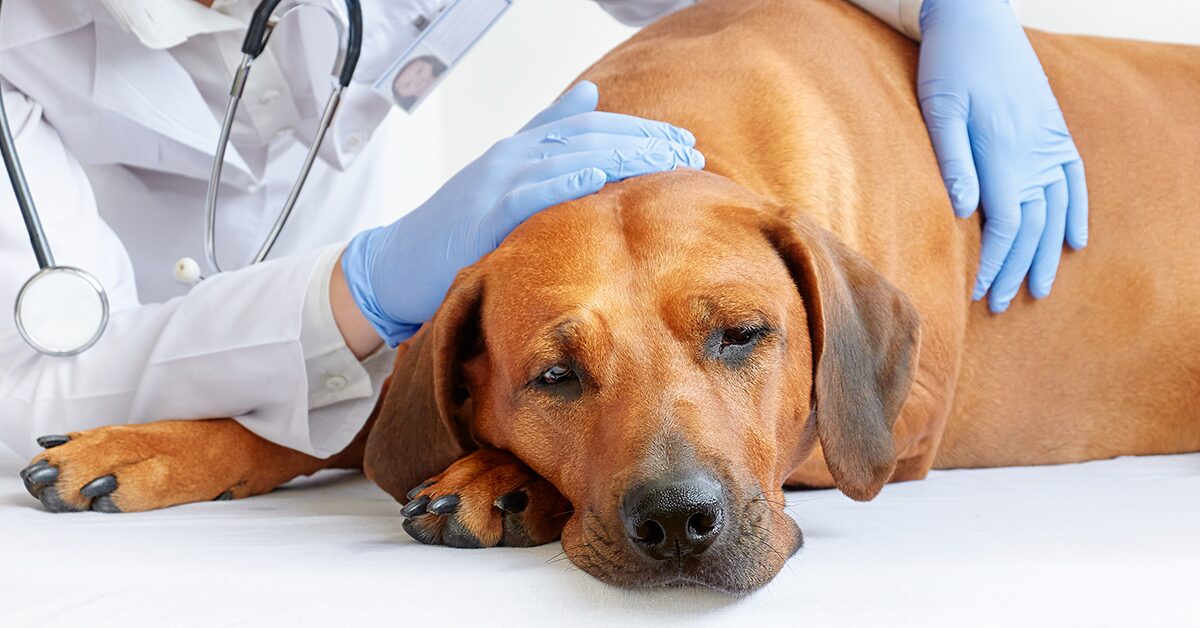When dogs have seizures, it can be very frightening, especially if it’s the first time you’ve seen one, or it’s happening to your dog.
Interestingly, seizures are the most frequently reported neurological condition in dogs. They can occur in a single episode or a cluster, and happen at sporadic times or occur at regular intervals.
To understand what is happening and what you can do, let’s break down seizures in dogs, their causes, and treatment.
What is a seizure?
Seizures are a temporary, involuntary electrical disturbance of normal brain activity, like an electrical short. They typically start in the cerebral cortex, or front of the brain, and may spread outward through the entire brain. Uncontrollable muscle activity often accompanies them. There may be a loss of consciousness, drooling, vocalizations, or loss of bladder or bowel control. Or, the seizure may be as simple as your dog snapping at the air, or acting like they are chewing gum.
Seizures often happen when the brain’s electrical activity is changing or refocusing. Most seizures occur when a dog is resting or sleeping. Examples are falling asleep during periods of activity, excitement, or around a feeding. In between seizures, your dog may appear completely normal.
It’s important to know that seizures are not painful. Your dog may display behaviors of confusion and even panic before or after the seizure, but it results from not knowing what is happening rather than pain. Of course, that is little comfort when watching your fur baby in the middle of a grand mal seizure.
Epilepsy is a term many assume means anytime a dog has a seizure, but it’s used when repeated episodes of seizures are happening. There are many causes and types of seizures, all with varying treatment options. Controlling them requires a diagnosis by a veterinarian or a veterinary neurologist to develop a treatment plan for your dog’s seizures.
Let’s look at types of seizures, what happens to the body when they occur, and what they look like.
Types of seizures in dogs
Seizures can affect the entire body and brain or just a portion of the body and brain. Here are the types of seizures that affect dogs.
Generalized seizures or grand mal seizures: These involve both sides of the brain and body. Both tonic (loss of muscle control) and clonic (involuntary jerking of limbs) actions and loss of consciousness accompany them.
Focal Seizures: These are partial motor seizures involving only one part of the brain or body. A dog won’t lose consciousness, however, they will display abnormal motor activity. You may observe facial twitching, chewing movement (gum-chewing action), blinking repeatedly, or paddling of one or more limbs.
Your dog may show fear or panic, not understanding what is happening. Alternatively, they may look glazed or lost.
Autonomic function disturbances may present as pupil dilation, drooling or salivation, urination, or defecation.
Psychomotor, or complex partial seizures: These display more abnormal behaviors than focal seizures will. Your dog may hallucinate or seem in an altered state with episodes of aggression, or not recognize or respond to you or family members. Fly-biting, or snapping at the air, is a typical example of these types of seizures.
Idiopathic epilepsy: This is the most common cause of seizures in dogs. It’s considered an inherited disorder with repeated episodes throughout the dog’s life with unknown exact causes.
What causes seizures in dogs?
A single seizure is not usually cause for concern, however, multiple seizures in a short period of time can be very dangerous. For example, most vets won’t be too concerned about one seizure per month, but two seizures within a 24-hour period is another story.
Reasons a dog could have a seizure:
- Epilepsy (the most common cause)
- Ingestion of poisons (including but not limited to chocolate, macademia nuts, pesticides, and rat poison)
- Liver disease or kidney disease
- Low blood calcium
- Head trauma
- Electrolyte problems
- Low blood sugar
- Brain birth defects
- Breed-related encephalitis – Pug, Maltese, Yorkshire terrier
- Stroke
- Brain cancer
- Inflammatory infectious disease – distemper, fungal infections, Neospora, Toxoplasia, tick-borne diseases including ehrlichiosis, Rocky Mountain Spotted Fever
Stages of a seizures in dogs
The pre-ictal or aura phase is the period preceding the seizure. Your dog will display altered behavior and it can last from a few seconds to minutes before a seizure. Some signs to look out for:
- Restlessness
- Whining or vocalizations
- Attention seeking behavior
- Shaking
- Salivation
The Ictal phase or active seizure phase is the period your dog is actively seizing. It can last from a few seconds to several minutes and vary in appearance. Some signs to look out for:
- Muscles extending and contracting will be very stiff
- Your dog will fall onto their side and shake or appear paralyzed
- They can draw their head back, and neck will be stiff
- Urination, defecation, and salivation can be uncontrolled
- If a dog seizes for over 5 minutes, it’s considered Status Epilepticus. It’s very serious and life-threatening. A dog in this condition needs immediate intravenous anti-convulsive medications, or the dog may die or suffer permanent brain damage. This situation always needs immediate emergency vet treatment.
During this phase, your dog’s body temperature can rise dangerously high. It’s called hyperthermia and brings its own set of problems to deal with. Hyperthermia is also classified as heat stroke but can come from a dog seizing as well.
The post-ictal or post-seizure phase is the period after the seizure when your dog’s brain is returning to its normal state. You may observe:
- Confusion or disorientation
- Panic
- Pacing
- Salivation
- Restlessness
- Increased thirst or hunger
- May not recognize you or be temporarily blind
There seems to be no correlation between the length of seizures and the duration of this phase, but most times, it can last up to an hour. After the seizure, you should talk to your vet to determine if your dog needs immediate care.
What to expect at the vet following a seizure
Your veterinarian will immediately want a thorough history of your dog’s health records as well as their whereabouts leading up to this point. They will look for any exposure to poisons, head trauma, and health conditions that may be the cause of the seizure.
Testing
- Blood tests and urine tests to rule out disorders of the liver, kidneys, and heart, as well as metabolic problems, electrolytes, blood sugar levels, and heartworm if the dog is not on a regular preventative plan.
- ECG
- Spinal fluid analysis in severe cases
- MRI which looks directly at brain structure or abnormalities
Treatment for seizures
Once a dog starts on anti-convulsive medications, they must remain on them throughout their life, unless the underlying cause of the seizures is resolved. If you stop their medications abruptly, your dog will be at risk for more severe or frequent seizures. For that reason, vets will be very careful in the diagnosis and treatment of seizures with your dog.
Typical criteria for starting a dog on seizure medications are:
- More than one seizure per month
- Cluster seizures
- Grand mal seizures
Seizure medications
The most common medication is phenobarbital or potassium bromide. The newer medications are Zonegran and Keppra. New research shows that CBD oil for dogs may reduce seizures in epilepsy. Sometimes, a dog will be on a combination of medications. Most of these anticonvulsant medications will need to be monitored with blood work regularly by your veterinarian to avoid negative side effects and assess efficacy in controlling seizures.
What dog breeds are more likely to have seizures?
Any dog can have a seizure at any age, but genetically the dog breeds that are 2-3 times more likely to have seizures are Pugs, Teacup Poodles, Boston Terriers, English Foxhounds, Lakeland terriers, and German Shepherds. Pomeranians and Chihuahuas can also be susceptible to seizures because they are predisposed to a condition called hydrocephalus, or water on the brain.
What can you do if your dog has a seizure?
Watching your beloved tail-wagger have a seizure is frightening. However, here are a few vet-recommended tips if you find your dog seizing.
- Stay calm! Your dog is not in pain and the seizure will be over shortly, even if it feels like it’s lasting forever. Most are over in a few seconds to a few minutes.
- Give your dog space. Make sure they are not around anything that can harm them, like a pool, sharp objects, or stairs. Be present, but don’t hold your dog or inhibit their movements.
- Don’t put your hands in your dog’s mouth. They will not swallow their tongue, but you could take a very nasty bite from a seizing dog.
- Log the details of the seizure.
- Take a video so the vet can see what happened. It can help with diagnosis.
- Note the day, time, and duration of the seizure.
- Detail anything you remember about what your dog looked like and acted like before and after the episode.
- Get your dog to a veterinarian immediately if the seizure lasts longer than 3-5 minutes. If it’s shorter, you should still talk to your vet to determine if a vet visit is in order.
It’s important to know that seizures are symptoms of underlying conditions and not a disease. Resolving the conditions can address the seizures, but there may not be a cure for your dog. However, there are some recommendations to keep your dog in optimum health, giving them a good prognosis if a seizure happens.
- Regular vet visits can catch early warning signs of conditions that cause seizures.
- Purchase puppies from reputable breeders that offer a health guarantee and regularly test their breeding stock for genetic disease.
- Feeding your dog a balanced diet will ensure they have all the nutrients their body needs to remain healthy
- Provide regular exercise




